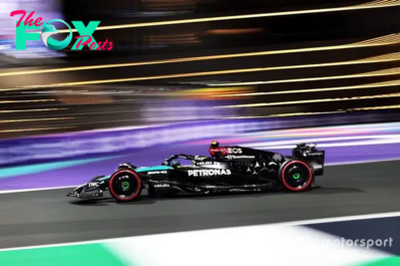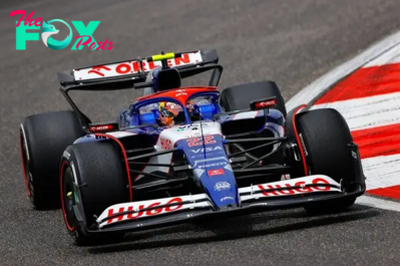F1 News
Five features on an F1 car that you may have missed
Teams spend months and even years working on improving the designs of their cars to make them lighter and faster in the hopes of beating the comPetition. There are many obvious elements on an F1 car's bodywork, including the front wing and the side pods, which all work together to make the car more aerodynamic.
However, there are several smaller features that can go unnoticed, especially during high-speed races. These features still play an integral part in the cars' design and can also be important safety features for both drivers and marshalls.
Ensuring safety is a key part of F1 car design, with many changes being made to the regulations to protect everyone working in and around the car. In the last decade, the FIA has introduced driver-facing cameras and the Halo to protect drivers in case of a crash.
Here are some features on an F1 car that you might have missed but are a key part of the car's design:
Neutral Button
The neutral button is on the car's nose and can be activated to put the vehicle into neutral from the outside. It appears as a red circle with an 'N' on the front of the car to clearly indicate the location of the button.
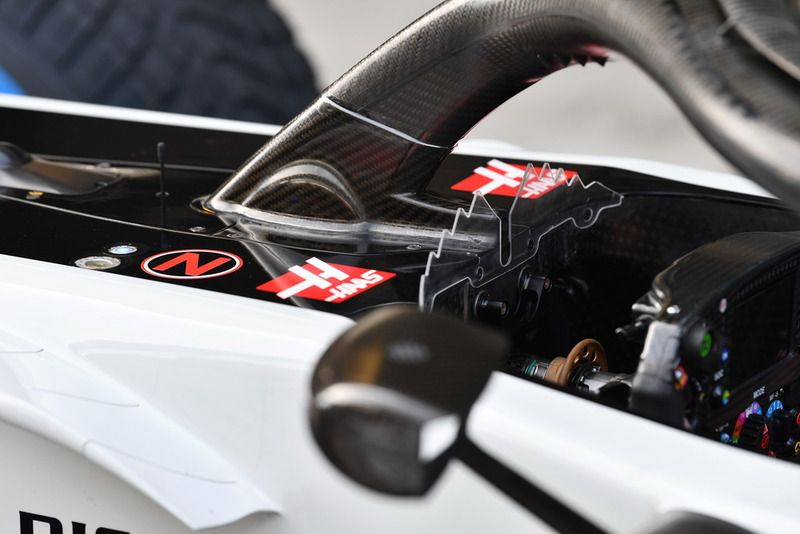
Haas F1 Team VF-18 halo detail
Photo by: Mark Sutton
Marshalls can push this button to change the car's transmission to assist with moving the vehicle if the driver has not disengaged the clutch. By putting the car into neutral, it will roll easily and marshalls are then able to move it to a safe position or to a recovery vehicle. This also allows for the car to be towed without causing any additional damage to the engine.
Although the neutral button is designed for stewards, it can be reached by drivers if their car is stuck in a gear, and they need to reduce the car's speed to get it to safety. Fernando Alonso was seen using the neutral button on his McLaren at the 2016 European Grand Prix in Baku after experiencing gearbox issues, which forced him to retire from the race.
The Spaniard was seen reaching from the cockpit of his car to find the button after he was unable to get the car out of gear 7. This enabled him to slow the car down and bring it safely to his team in the pits, without causing damage to his car or a delay to the race.
Electric Switch
Like the neutral button, there is also an 'E' in a red circle on the side of an F1 car, and is a handle which comes out from the bodywork. This feature has been part of car design since the 1970s.
This handle turns off the electric circuit breaker in the car, making it safe for marshalls to touch the vehicle if they need to recover it. However, there is also a similar button on the inside of the cockpit, which allows the driver to be able to cut the power to the car themselves.
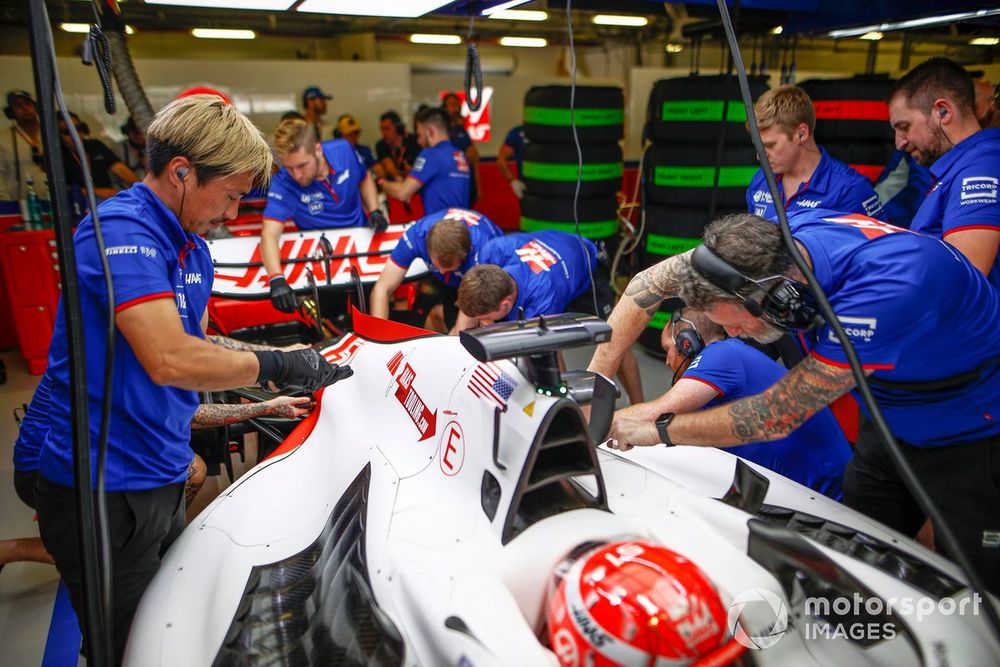
Mechanics work on the car of Pietro Fittipaldi, Haas VF-22, in the garage
Photo by: Andy Hone / Motorsport Images
By pulling the switch it ensures that the car doesn't electrocute any marshalls who might be working on the vehicle - especially if a driver needs to be recovered from the inside - but also stops the car from sparking which could start a fuel fire.
When the switch is pulled, the onboard fire extinguisher is also activated to help prevent any fires.
Electric Recovery System Alert Light
The electric recovery system alert light is just one of a few lights on the roll hoop which indicate the status of the car's electrical system to teams and marshalls. They make up a group of seven lights which can be seen from anywhere around the car so that anybody in or around the car can be aware of any potential risk of electrocution.
The light will glow red to indicate: "Unsafe, do not touch the vehicle unless wearing appropriate safety gear, risk of shock". This warns that there is an electrical current live in the car and that there is a risk to a person's Health if they touch the vehicle.
It can also glow yellow – which suggests the car is on and the battery is charged and that there is a possible risk of being electrocuted if someone touches the car. The green light indicates that the car is stopped and there is no risk, so the car is safe to approach and touch.
The lights can also glow purple which indicates that the car is in the pitlane and that its speed limiter is active. A final light on the chassis performs as a medical warning light, which will turn blue if the car has been in a crash, this then flashes blue if the crash was significant and over 15G (g-forces). If this light flashes it can indicate to marshalls that drivers may need help and will be required to go to the medical centre to be checked over.
The driver will also have lights inside their cockpit to indicate whether it is safe to evacuate themselves from the car. If the light is red, then the driver will need to climb from the car and jump wide to ensure they do not earth themselves whilst still touching the vehicle, which could result in them being electrocuted.
Carbon fibre can conduct electricity and with only the rubber tyres touching the track, the cars are not grounded. An electrical current needs to be grounded to be safe, meaning that the entire body of the car has electricity running through it and that marshalls need to wear rubber gloves to prevent electrocution.
The light can remain live even if the car is stationary, which indicates to marshalls that the risk is still present.
In 2019, Daniel Ricciardo was investigated by the FIA for not leaving his steering wheel in place when leaving his vehicle. At the Bahrain Grand Prix, the Australian's car stopped on Turn 2 after a power unit failure. The ERS system alert light turned red which indicated that the car was electrically unsafe and Ricciardo was told to shut down the car and to jump from the vehicle without touching it and the ground at the same time.
The Renault driver followed normal safety procedures to evacuate the vehicle and claimed it would be too dangerous to replace the steering wheel if the car was electrically charged. After an investigation, he was found to have not breached Article 22.5 of the sporting regulations.
At the 2021 Dutch Grand Prix, the Aston Martin team were seen ensuring that Sebastian Vettel's car was electrically safe to touch. The German had broken down during FP1 and began leaking oil onto the track, with the added concern that the car could catch fire.
Windscreen
Windscreens have appeared on F1 cars for decades; however, a smaller and less noticeable design was introduced on Nico Rosberg's Mercedes in 2016, which has since been adopted by the rest of the teams. The jagged edge is designed to add further aerodynamic benefits which minimise drag and maximise downforce by creating smaller vortices than a straight single edge would create.
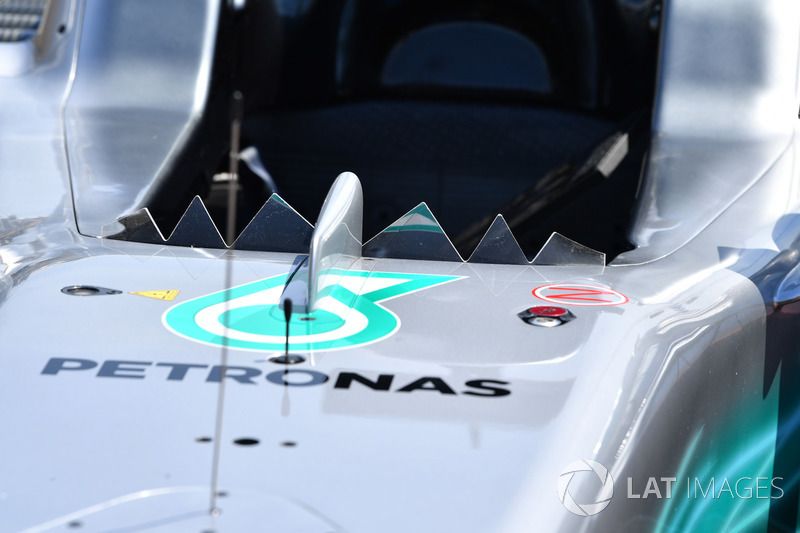
Mercedes-Benz F1 W08 windscreen detail
Photo by: Sutton Images
The smaller vortices also reduce noise to a lower volume but higher pitch which does not Travel as far as a higher volume low pitch, and are less impactful when they reach the driver's head and rear wing. This can reduce the driver's head crashing around in comparison to one larger air vortex.
The windscreen acts by stopping the air slightly to push the air up and over the driver and the sides, instead of into the cockpit and the driver's chest – making it less taxing on the person behind the wheel.
The design - sometimes known as "dragon teeth" - helps change the direction of the roll of air upwards. The teeth also push pairs in opposing directions of each bump, which can help dissipate the air by cancelling each other out, making them less impactful as they move towards the driver.
Skid Block
The skid block was made a mandatory part of an F1 car in 1994 and is used on the bottom of the chassis to impose a minimum ride height (ground clearance) and limit the use of ground effects to improve vehicle handling. The block is a flat rectangular device that is usually made out of fibreglass but was previously made of a wood composite called Jabroc.
They were introduced following the deaths of both Ayrton Senna and Roland Ratzenberger at the 1994 San Marino Grand Prix. The FIA brought in the skid blocks to increase the car's height and reduce downforce, which has resulted in fewer accidents and deaths.
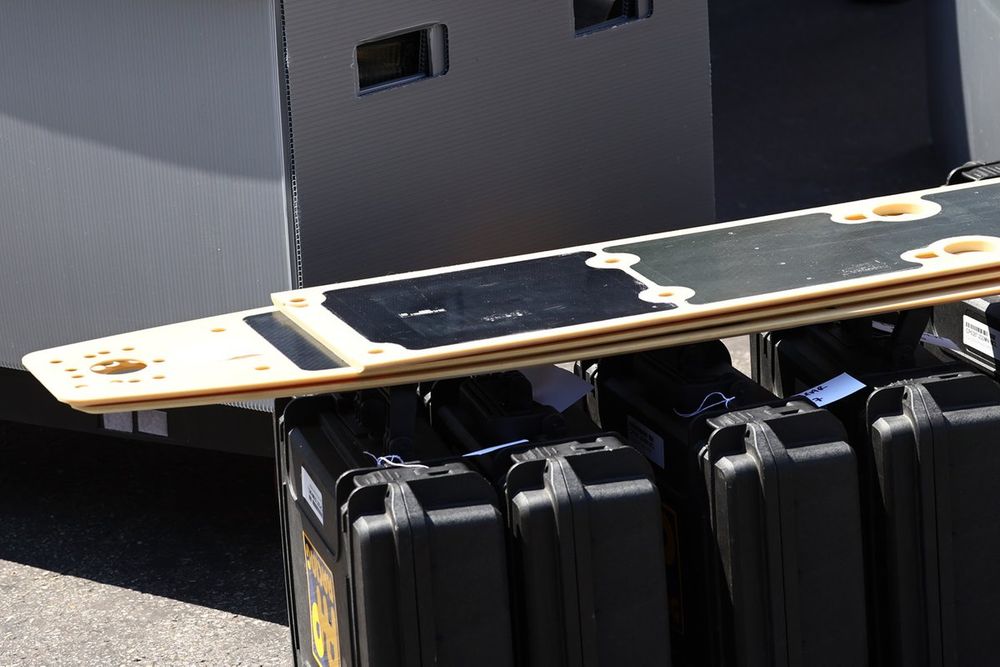
McLaren MCL36 plank
Photo by: Giorgio Piola
The introduction of the block meant that engineers had to completely redesign their cars to ensure they met regulations. Each car needed to reach a certain height to reduce damage to the skid block, as a car can be disqualified for being too damaged.
The FIA regulations state that each skid block must be 10mm thick with around a 0.2mm allowance either way, however regulations also state: "A minimum thickness of 9mm will be accepted due to wear, and conformity to this provision will be checked at the peripheries of the designated holes". Wear is measured to the skid block by measuring six bolts which are drilled into the car's plank. If wear on the bolts is greater than 1mm then the driver will be disqualified.
This was seen at the 2023 United States Grand Prix when Lewis Hamilton and Charles Leclerc were both disqualified from the race after their skid blocks had been "excessively worn down". This resulted in Lewis Hamilton losing his second-place podium and both being the first drivers to be disqualified for excessive plank wear since Michael Schumacher in his Benetton at the 1994 Belgian Grand Prix.
Teams will strategically place smaller titanium plates that are no bigger than 3mm in depth which protect the main skid block from excessive wear. These plates cause the sparks that we are used to seeing fly from the back of an F1 car when they are driving at higher speeds on the straight - which is caused by downforce pushing the car closer to the track.
Watch: F1 2024 Chinese Grand Prix Preview – Everything You Need To Know
-

 F1 News1d ago
F1 News1d agoNorris: F1 might never have a driver with Alonso's longevity again
-

 F1 News1d ago
F1 News1d agoThe changes that resulted from F1’s evolution into a truly global player
-
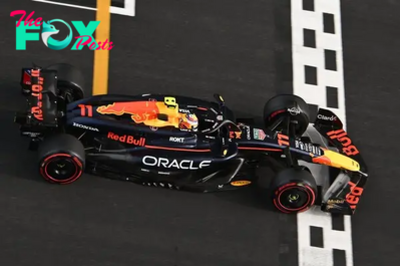
 F1 News2d ago
F1 News2d agoRed Bull being as "ballsy" with F1 engine as it is with title-winning cars
-

 F1 News2d ago
F1 News2d agoHow studying Tost, Whiting and Binotto shaped F1's latest team boss
-

 F1 News2d ago
F1 News2d agoF1 chief Domenicali eyes more sprint weekends
-

 F1 News2d ago
F1 News2d ago12 years late: How Hulkenberg is finally getting his shot at a ‘big’ F1 team
-
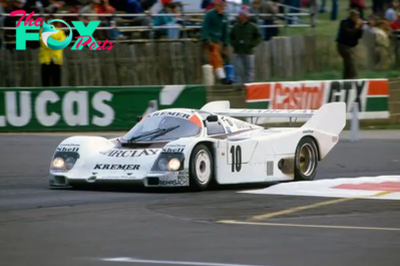
 F1 News3d ago
F1 News3d agoHow a sportscar friendship prevailed over F1 rivalry
-

 F1 News3d ago
F1 News3d agoAndretti Cadillac to hire 60 UK staff as F1 push continues






